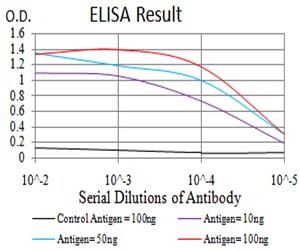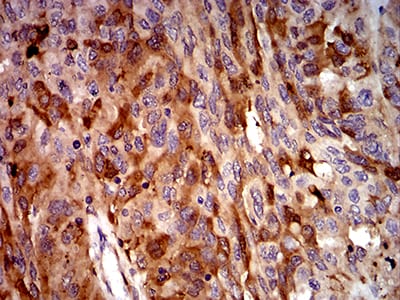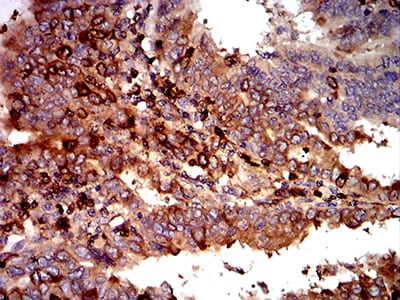


| WB | 咨询技术 | Human,Mouse,Rat |
| IF | 咨询技术 | Human,Mouse,Rat |
| IHC | 1/25-1/100 | Human,Mouse,Rat |
| ICC | 技术咨询 | Human,Mouse,Rat |
| FCM | 咨询技术 | Human,Mouse,Rat |
| Elisa | 1/2000-1/5000 | Human,Mouse,Rat |
| Aliases | ASP; C3a; C3b; AHUS5; ARMD9; CPAMD1; HEL-S-62p |
| Entrez GeneID | 718 |
| clone | 8B5H2 |
| WB Predicted band size | 187.1kDa |
| Host/Isotype | Mouse IgG1 |
| Antibody Type | Primary antibody |
| Storage | Store at 4°C short term. Aliquot and store at -20°C long term. Avoid freeze/thaw cycles. |
| Species Reactivity | Human |
| Immunogen | Purified recombinant fragment of human C3C (AA: 1521-1649) expressed in E. Coli. |
| Formulation | Purified antibody in PBS with 0.05% sodium azide |
+ +
以下是关于MARK1抗体的3篇参考文献及其摘要概括:
---
1. **文献名称**:*MARK, a novel family of protein kinases that phosphorylate microtubule-associated proteins and trigger microtubule disruption*
**作者**:Drewes G., et al.
**摘要**:该研究首次鉴定了哺乳动物中的MARK激酶家族(包括MARK1),发现其通过磷酸化微管相关蛋白(如tau)导致微管结构解体。研究使用特异性抗体证实MARK1在调控神经元微管稳定性中的作用,与阿尔茨海默病中tau病理相关。
2. **文献名称**:*The role of PAR-1/MARK kinase in microtubule dynamics and cytoskeletal organization*
**作者**:Trinczek B., et al.
**摘要**:通过免疫荧光和Western blot分析,研究发现MARK1(PAR-1)抗体标记显示其在细胞分裂和极性形成中的定位。实验表明MARK1通过磷酸化调控微管结合蛋白,影响细胞骨架重组与神经元形态发生。
3. **文献名称**:*MARK/Par-1 kinase is activated through a PKC-dependent pathway and regulates microtubule dynamics*
**作者**:Matenia D., et al.
**摘要**:该文献利用MARK1特异性抗体揭示其在神经元中的表达模式,并发现其活性受PKC信号调控。研究证明MARK1磷酸化tau蛋白,导致微管网络动态失衡,提示其在神经退行性疾病中的潜在机制。
---
以上文献均涉及MARK1抗体的应用,涵盖其功能验证、亚细胞定位及与疾病相关的分子机制。如需具体实验细节,可进一步查阅全文。
The MARK1 (Microtubule Affinity-Regulating Kinase 1) antibody is a crucial tool for studying the function and regulation of the MARK1 protein, a serine/threonine kinase belonging to the PAR1 (Partitioning Defective 1) family. MARK1 plays a pivotal role in establishing cell polarity, regulating microtubule dynamics, and maintaining neuronal integrity by phosphorylating microtubule-associated proteins (e.g., tau, MAP2/4). This phosphorylation destabilizes microtubule binding, influencing cellular architecture and trafficking. Dysregulation of MARK1 is implicated in neurodegenerative diseases, particularly Alzheimer’s disease, where hyperphosphorylated tau forms neurofibrillary tangles.
The MARK1 antibody enables detection and quantification of MARK1 expression in various experimental models, including Western blotting, immunofluorescence, and immunohistochemistry. It helps elucidate MARK1's interaction networks, activity under stress or disease conditions, and its role in signaling pathways like Wnt or AMPK. Researchers also use it to study MARK1's involvement in developmental processes, cancer (cell cycle disruption), and synaptic plasticity.
Commercial MARK1 antibodies are typically raised in rabbits or mice against specific epitopes, with validation in knockout controls to ensure specificity. Its applications span basic research, drug discovery, and diagnostic development, making it indispensable for exploring MARK1's dual roles in physiological homeostasis and pathological mechanisms. Ongoing studies focus on its therapeutic potential in targeting tauopathies and cancer metastasis.
×